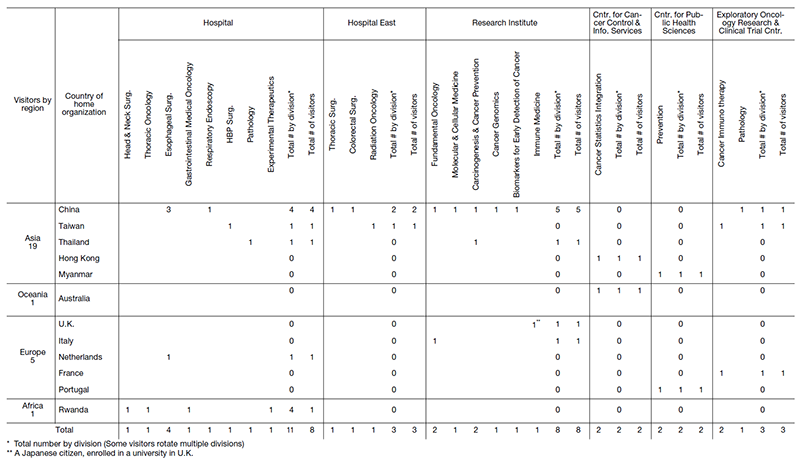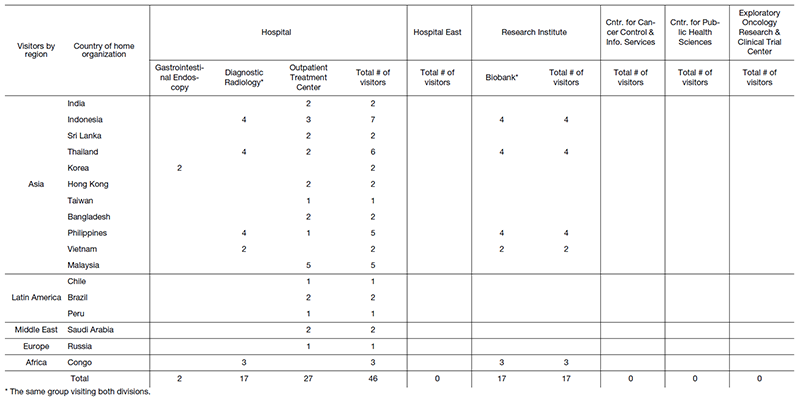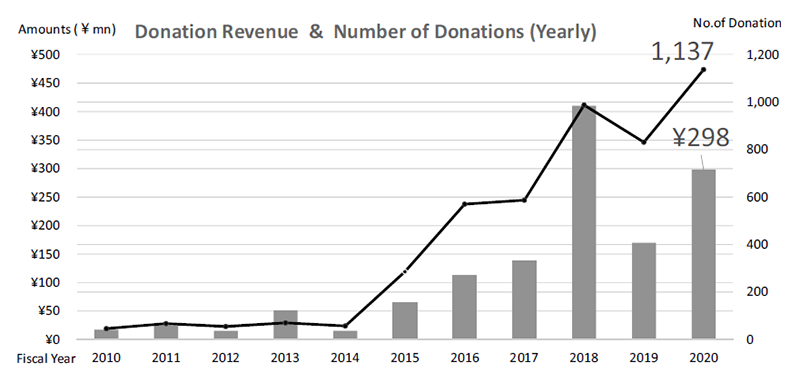Strategic Planning Bureau
I. Office of Government Affairs
Tatsuya Suzuki, Toshio Miyata, Toshiyuki Sato, Tomofumi Hamaguchi, Natsuko Okita, Hirokazu Takahashi
The Team and What We Do
Out team monitors government related committees and conferences and report updates to the board of directors, director’s meeting, and the center-wide management meeting.
Education
Through secondments to and from central governmental agencies and affiliated organizations including the Ministry of Health, Labour and Welfare, our staff gain expertise on policy monitoring and advocacy.
Future Prospects
Working with individual units, we will strengthen the center’s advocacy, responding to policy formation processes on the part of government as appropriate.
Author
Tatsuya Suzuki
II. Strategic Planning Bureau
Takaaki Tsuchida, Miyako Horikoshi, Toru Kishida, Yumi Kitada, Kentaro Takeda, Kiyotaka Yoh, Reina Kyo, Eiko Saito, Yuka Takahashi
Introduction
The Office of Public Relations has been organized as one branch of the Strategic Planning Bureau Director-General, which was assigned as a public section under the supervision of the president of the National Cancer Center (NCC) in April 2013. A full-time staff member was newly assigned to the Office of Public Relations in April 2014. Our task is to manage the NCC website (https://www.ncc.go.jp), publication of reports, coverage and delivery of press conferences and press releases. By sharing the mission and vision between staff members throughout the NCC, we provide information about the NCC’s most outstanding activities in cancer care, research, screening, prevention, and policy making.
Our team and what we do
During weekly meetings of the Office of Public Relations, we perform prompt decision making regarding the public relations policy and share information about our tasks using a TV conference system between the Tsukiji and Kashiwa campuses. We receive information on the publicity work from each department, and draft a publication plan. In addition, through the distribution of the intramural information for staff members in the NCC, we share vital messages via e-mail, bulletin board, and/or information magazine to facilitate communication between the staff and executives. We distribute information promptly by publishing and sharing press releases, press conferences, and seminars about novel treatment, research activity and notable accomplishments within the NCC and elsewhere.
- Website and SNS improvement and updates
- Public information magazine “The National Cancer Center News”: for external hospitals, academia, research institutions, and administrative agencies
- Public information magazine “hibiho”: for patients in the NCC Hospital (NCCH) and the NCC Hospital East (NCCHE)
- Support for events, seminars, and public information
- Media support at press conferences, press releases, and media coverage
We held 14 press conferences and published 52 press releases. The total number of media coverage was 1127.
Future prospects
It is important to make the NCC website attractive, useful and accessible. It is also important to advance public relations activities. All staff share the NCC mission and move in the same direction.
III. Office of International Affairs
Tomohiro Matsuda, Seiichiro Yamamoto, Kay Ohara, Laureline Gatellier, Tomoko Shimmura, Mitsuko Otani, Akane Taminaga, Keiko Imai, Miwa Tokumoto, Satsuki Suzuki, Kimiko Oka
What We Do
The NCC’s Office of International Affairs promotes the Center’s international activities through:
1. Personnel exchange with leading medical institutions, nurturing cancer researchers / healthcare professionals, and a global network,
2. Participation in international collaborative cancer research projects, and outreach to the international medical community,
3. Sharing our medical expertise and information with overseas colleagues, with a focus on Asia, advancing cancer care and research in the region, and
4. Engagement with the community at large.
The Office of International Affairs serves as a conduit to, and supports the abovementioned activities.
1. Collaboration with International Agencies and Nurturing Human Resources
Dr Manami Inoue was nominated a Scientific Council member at the International Agency for Research on Cancer (IARC) of the World Health Organization (WHO), and was elected vice chair. At the Governing Council, Dr Hitoshi Nakagama, the President proposed to develop more projects in Asia. Through collaboration with the Ministry of Health, Labour and Welfare, the policy of activating more initiatives in Asia was incorporated in the new medium term strategy of IARC.
The Center joined the International Collaboration for Cancer Classification and Research (IC3R), a new initiative to set standards for research and evidence appraisal for tumour classification and cancer diagnosis. Dr Atsushi Ochiai, Director – Exploratory Oncology Research and Clinical Trial Center (EPOC), as standing member of the editorial board, contributed to the WHO/IARC Classification of Tumours Series. Another seminar was coorganized with IARC in October, in which Dr Eva Steliarova-Foucher of IARC, and Dr Joanne Aitken, the President of the International Association of Cancer Registries, spoke on paediatric cancer registration. The memorandum of understanding on the Global Initiative for Cancer Registry Development (GICR) with IARC was renewed, and the Center was redesignated a Collaboration Centre for GICR.
Following the Franco-Japanese Pediatric Cancers workshop held in December 2019, staff won a grant to observe early-phase drug development sponsored by the French embassy in Tokyo, and a visiting scientist won a grant for joint collaboration with Gustave Roussy from the French National Cancer Institute (INCa). The Directors of respective research institutes of INCa and NCC held discussions for future collaborations. Staff was seconded to the Danderyd Hospital, Karolinska Institute, to participate in a joint research program.
Virtual conferences were held with the new director of Center for Global Health at National Cancer Institute (NCI) USA, Netherlands Cancer Institute (NKI), and with Netherlands Comprehensive Cancer Organisation (IKNL), to discuss future collaboration.
We also took part in the General Assembly of the Union for International Cancer Control (UICC) in October, and the Covid-19 and Cancer Task Force, co-authoring a number of papers. Dr Yukihide Kanemitsu of our hospital presented on Japanese colorectal surgery techniques for the St Petersburg Oncocentre.
2. Collaborative Medical Research
The NCC continues its participation in multiple international collaborative research programs and international clinical trials, which logistics the Office of International Affairs supports, whilst serving as a conduit of information between the research teams. More details can be found in other sections within this annual report.
3. Medical Contribution, with a focus on Asia
We hosted 25 medical staff from overseas institutions on visits to our two campuses during fiscal year 2020. Given that there were less visitors, we produced a video clip introducing visits to our center, and relayed information on webinars in which our doctors presented, to alumni and to prospective visitors.
Serving as secretariat to Asian National Cancer Centres Alliance (ANCCA), we coordinated to revise the constitution, supported the annual top level virtual meeting, and coordinated to jointly publish a document on infection control measures among members’ hospitals.
A virtual meeting on infection control was held with the National Cancer Centers of China and of Korea in April, followed by another meeting on cancers common in Asia in September. With Tianjin Medical University Cancer Institute and Hospital an MoU was concluded in July, and another with Seoul National University College of Medicine in August.
With Southeast Asia, we visited the Royal Thai Embassy in Japan in June, and in November His Excellency the Ambassador Mr Singtong Lapisatepun visited in return. MoUs were concluded with Ho Chi Minh City Oncology Hospital in May, and with Clinical Research Malaysia in October, consolidating our relationship with key institutions towards a stronger foundation for collaboration. Upon launching the ATLAS project, we relayed information to foreign language media.
In South Asia, thanks to an invitation from the Ministry of Foreign Affairs, we organized a virtual meeting with the Ministry of Health, Bhutan and Jigme Dorji Wamgchuck National Referral Hospital, to discuss possible collaborations in future. We also committed to collaborate in the project organized by Japan International Cooperation Agency (JICA) for improving cancer services in the state of Tamil Nadu.
We also participated in JICA’s project to improve palliative care in the state of Moldova. As a member of the SUCCESS consortium, we continued to liaise with Expertise France in preparation for the time when cooperation would resume.
To support our efforts to contribute to international medical needs, we also published a booklet to prepare our staff on international patients.
4. External Engagement
Supporting the Center’s outreach activities to our global partners, we are placing a renewed focus on engaging third parties domestically, including industry. We continued issuing a monthly internal newsletter to share information on international engagement, encouraging more staff to take part in global activities. More was done reaching out to the Ministry of Health, Labour and Welfare, Ministry of Foreign Affairs, National Institute of Public Health, Japan International Cooperation Agency, and the Nagoya University Graduate School of Medicine.
Table 1. April 2020 - March 2021: Visits

* Total number (Some visitors rotate multiple divisions)

* Total number by division (Some visitors rotate multiple divisions)
** A Japanese citizen, enrolled in a university in U.K.

* The same group visiting both divisions.
IV. Office of Development
Chie Matsuda, Atsushi Takano, Kimiko Oka, Yuki Inokawa
What We Do
We receive limited funding from the Japanese Government at around 10% of our total cash inflow. Currently, the NCC’s main sources of cash flow are revenues from medical services, cancer research, and clinical trials. It is vital to diversify those revenue sources to make the NCC’s financial position stable over the long term. As one of the alternatives, we look for sustainable growth in donation revenue from the NCC supporters.
What We Achieved in FY2020
Donation revenue was ¥298 million (+76% YoY), 1,137 donations (+37% YoY), respectively in FY2020. It has shown the consecutive increasing trend since FY2015, both in value and numbers, apart from FY2018, a large legacy gift (¥190mn) was received. The main factors for the revenue growth are as follows:
1. Diversification in donors’ portfolio, from the NCCH/NCCH EAST patients to other segments
2. An increase in legacy gifts
What We will Do - Priorities in FY2021
We will focus on the following measures:
1. To diversify donors’ portfolio from the NCCH/ NCCH EAST patients to all those who support the NCC’s vision, “Don’t get cancer, not beaten by cancer, and live with cancer.” We will continue to conduct publicity activities to inform the reason why we need funding and how the funding is spent, with the launch of “The National Cancer Center Foundation” in 2020. With the COVID-19 pandemic, various non-medical companies have proposed to support medical workers as part of their efforts toward the SDGs achievements. We will take this as an opportunity for the NCC.
2. To encourage legacy giving for future cancer research from senior/upper-middle class people who are interested in philanthropy, we will continue to seek collaboration with professionals in that field, including NPOs that support legacy giving, lawyers, accountants, and trust banks.
Figure 1. Donation Revenue & Number of Donations (Yearly)

